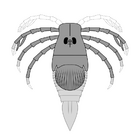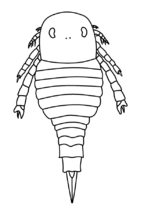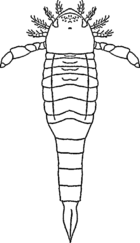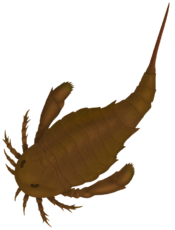Biology:List of eurypterid genera
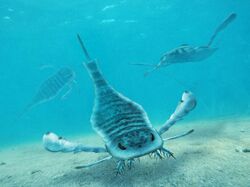
This list of eurypterid genera is a comprehensive listing of all genera that have ever been included in the order Eurypterida, excluding purely vernacular terms. The list includes all commonly accepted genera, but also genera that are now considered invalid, doubtful (nomen dubium), or were not formally published (nomen nudum), as well as junior synonyms of more established names and genera that are no longer considered eurypterids. The list currently includes 115 names out of which 74 are considered valid eurypterid genera.
There are approximately 250 species of eurypterids recognized as valid.[1]
Naming conventions and terminology
There is no "official" or "canonical" list of eurypterid genera. The closest thing is found contained in the regularly updated Summary list of fossil spiders and their relatives in the World Spider Catalog. The vast majority of the content of the list below, including the valid genera, preoccupied names, junior synonyms, taxonomical classifications and sites of discovery, is based upon the 2018 edition of the Summary list. Content not based on the list, such as genera described after its publication, is noted through inline citations.
Naming conventions and terminology follow the International Code of Zoological Nomenclature. Technical terms used include:
- Junior synonym: A name which describes the same taxon as a previously published name. If two or more genera are formally designated and the type specimens are later assigned to the same genus, the first to be published (in chronological order) is the senior synonym, and all other instances are junior synonyms. Senior synonyms are generally used, except by special decision of the ICZN, but junior synonyms cannot be used again, even if deprecated. Junior synonymy is often subjective, unless the genera described were both based on the same type specimen.
- Nomen nudum (Latin for "naked name"): A name that has appeared in print but has not yet been formally published by the standards of the ICZN. Nomina nuda (the plural form) are invalid, and are therefore not italicized as a proper generic name would be. If the name is later formally published, that name is no longer a nomen nudum and will be italicized on this list. Often, the formally published name will differ from any nomina nuda that describe the same specimen.
- Nomen manuscriptum (Latin for "manuscript name"): A name that appears in manuscript of a formal, but not-peer-reviewed, publication that has no scientific backing. A nomen manuscriptum is equivalent to a nomen nudum for everything except the method of publication, and description.
- Nomen oblitum (Latin for "forgotten name"): A name that has not been used in the scientific community for more than fifty years after its original proposal.
- Preoccupied name: A name that is formally published, but which has already been used for another taxon. This second use is invalid (as are all subsequent uses) and the name must be replaced. As preoccupied names are not valid generic names, they will also go unitalicized on this list.
- Nomen dubium (Latin for "dubious name"): A name describing a fossil with no unique diagnostic features.
Eurypterid genera
|
Eurypterid ichnogenera
|
See also
- Timeline of eurypterid research
- List of xiphosuran genera
- List of trilobite genera
- List of ammonite genera
- List of prehistoric malacostracans
References
General
- Dunlop, J. A., Penney, D. & Jekel, D. 2018. A summary list of fossil spiders and their relatives. In World Spider Catalog. Natural History Museum Bern.
Citations
- ↑ 1.0 1.1 1.2 Dunlop, J. A., Penney, D. & Jekel, D. 2018. A summary list of fossil spiders and their relatives. In World Spider Catalog. Natural History Museum Bern
- ↑ 2.0 2.1 O. Erik Tetlie (2006). "Two new Silurian species of Eurypterus (Chelicerata: Eurypterida) from Norway and Canada and the phylogeny of the genus". Journal of Systematic Palaeontology 4 (4): 397–412. doi:10.1017/S1477201906001921. ISSN 1478-0941. http://www.museunacional.ufrj.br/mndi/Aracnologia/Eurypterida/Tetlie%202006%20Silurian%20Eurypterus.pdf. Retrieved May 20, 2011.
- ↑ Bicknell, Russell D. C.; Smith, Patrick M.; Poschmann, Markus (2020). "Re-evaluating evidence of Australian eurypterids". Gondwana Research 86: 164–181. doi:10.1016/j.gr.2020.06.002. Bibcode: 2020GondR..86..164B. https://www.sciencedirect.com/science/article/abs/pii/S1342937X20301799.
- ↑ Rolfe, William; Dzik, Jerzy (2006-12-01). "Angustidontus, a Late Devonian pelagic predatory crustacean". Transactions: Earth Sciences 97: 75–96. doi:10.1017/S0263593300001413. https://www.researchgate.net/publication/233549008.
- ↑ Miller, Randall F. (1995-08-01). "The status of Belinuropsis wigudensis Matthew, 1910, a Pennsylvanian merostome from New Brunswick, Canada". Atlantic Geology 31 (2). doi:10.4138/2104. ISSN 1718-7885. https://journals.lib.unb.ca/index.php/ag/article/view/2104.
- ↑ Anderson, Lyall I.; Moore, Rachel A. (2003). "Bembicosoma re-examined: a xiphosuran from the Silurian of the North Esk Inlier, Pentland Hills, Scotland". Transactions of the Royal Society of Edinburgh: Earth Sciences 94 (3): 199–206. doi:10.1017/S0263593300000614. https://www.cambridge.org/core/journals/earth-and-environmental-science-transactions-of-royal-society-of-edinburgh/article/bembicosoma-reexamined-a-xiphosuran-from-the-silurian-of-the-north-esk-inlier-pentland-hills-scotland/DFB7E5DD24F184786D1769B5DBBD45F2.
- ↑ Miller, Randall F.; Tetlie, O. Erik (2007). "The presumed Synziphosuran Bunodella horrida Matthew, 1889 (Silurian; Cunningham Creek Formation, New Brunswick, Canada) is a eurypterid". Journal of Paleontology 81 (3): 588–590. doi:10.1666/05127.1.
- ↑ Waterston, Charles D. (1958). "XII.—The Scottish Carboniferous Eurypterida". Transactions of the Royal Society of Edinburgh 63 (2): 265–288. doi:10.1017/S0080456800009492. https://www.cambridge.org/core/journals/earth-and-environmental-science-transactions-of-royal-society-of-edinburgh/article/xiithe-scottish-carboniferous-eurypterida/27C454542B1D42B89B354EC440ED7126.
- ↑ Tetlie, Odd Erik (2004). Eurypterid phylogeny with remarks on the origin of arachnids (PhD). University of Bristol. pp. 1–344.
- ↑ 10.0 10.1 Hughes, Emily Samantha (2019). Discerning the diets of sweep-feeding eurypterids through analyses of mesh-modified appendage armature (MS thesis). West Virginia University. pp. 1–61. doi:10.33915/etd.3890.
- ↑ "†Eurypterida" (in en). http://www.helsinki.fi/~mhaaramo/metazoa/protostoma/arthropoda/eurypterida/eurypterida_1.html.
- ↑ Dunlop, Jason A.; Miller, Randall F. (2007-10-16). "The fossil arachnid genus Eurymartus MATTHEW, 1895 and the eurypterid genus Eurypterella MATTHEW, 1889 from the Late Carboniferous" (in en). Neues Jahrbuch für Geologie und Paläontologie - Abhandlungen 245 (3): 295–300. doi:10.1127/0077-7749/2007/0245-0295. https://www.schweizerbart.de/papers/njgpa/detail/245/59169/The_fossil_arachnid_genus_Eurymartus_MATTHEW_1895_and_the_eurypterid_genus_Eurypterella_MATTHEW_1889_from_the_Late_Carboniferous_Fern_Ledges_of_Saint_John_New_Brunswick_Canada?l=FR.
- ↑ 13.0 13.1 13.2 13.3 Størmer, Leif. "A new eurypterid from the Ordovician of Montgomeryshire, Wales." Geological Magazine; November 1951; v. 88; no. 6; p. 409-422.
- ↑ D. Waterston, Charles (1964-01-01). "II.—Observations on Pterygotid Eurypterids". Transactions of the Royal Society of Edinburgh 66 (2): 9–33. doi:10.1017/S0080456800023309. https://www.researchgate.net/publication/259412608.
- ↑ Niklas, Karl J. (1976). "Morphological and Ontogenetic Reconstructions of Parka decipiens Fleming and Pachytheca Hooker from the Lower Old Red Sandstone, Scotland". Transactions of the Royal Society of Edinburgh 69 (21): 483–499. doi:10.1017/S0080456800015507. https://www.cambridge.org/core/journals/earth-and-environmental-science-transactions-of-royal-society-of-edinburgh/article/21morphological-and-ontogenetic-reconstructions-of-parka-decipiens-fleming-and-pachytheca-hooker-from-the-lower-old-red-sandstone-scotland/15260D8681E6CA5739D5C8F1643F85BE.
- ↑ Lamsdell, James C.; Briggs, Derek E. G.; Liu, Huaibao P.; Witzke, Brian J.; McKay, Robert M. (2015-09-01). "The oldest described eurypterid: a giant Middle Ordovician (Darriwilian) megalograptid from the Winneshiek Lagerstätte of Iowa". BMC Evolutionary Biology 15: 169. doi:10.1186/s12862-015-0443-9. ISSN 1471-2148. PMID 26324341.
- ↑ Novojilov, N. (1958). Aleksandr Grigorevich Sharov. ed. Polystomurum strømeri new genus and species of Eurypterida from the Devonian of the region of Voronell. Mat. Princip. Paleont. (Moscow). 2. pp. 47–50. https://books.google.com/books?id=4XCABwAAQBAJ.
- ↑ Walcott, Charles Doolittle (1911). "Cambrian Geology and Paleontology". Smithsonian Miscellaneous Collections 57 (2): 17–40. https://en.wikisource.org/wiki/Cambrian_Geology_and_Paleontology/Volume_2/Middle_Cambrian_Merostomata.
- ↑ Zhang, Xingliang; Han, Jian; Shu, Degan (2002). "New occurrence of the Burgess Shale arthropod Sidneyia in the Early Cambrian Chengjiang Lagerstätte (South China), and revision of the arthropod Urokodia". Alcheringa: An Australasian Journal of Palaeontology 26 (1): 1–8. doi:10.1080/03115510208619239.
- ↑ Plax, Dmitry P.; Lamsdell, James C.; Vrazo, Matthew B.; Barbikov, Dmitry V. (2018). "A new genus of eurypterid (Chelicerata, Eurypterida) from the Upper Devonian salt deposits of Belarus". Journal of Paleontology 92 (5): 838–849. doi:10.1017/jpa.2018.11. https://www.researchgate.net/publication/326233486.
- ↑ Hou, X.-G; Bergström, J (1997-12-22). "Arthropods of the Lower Cambrian Chengjiang fauna, southwest China". Fossils and Strata 45: 1–116. https://www.researchgate.net/publication/279900184.
- ↑ Wang, Han; Dunlop, Jason A.; Gai, Zhikun; Lei, Xiaojie; Jarzembowski, Edmund A.; Wang, Bo (2021). "First mixopterid eurypterids (Arthropoda: Chelicerata) from the Lower Silurian of South China". Science Bulletin 66 (22): 2277–2280. doi:10.1016/j.scib.2021.07.019. PMID 36654455. Bibcode: 2021SciBu..66.2277W. https://www.researchgate.net/publication/353240547.
- ↑ Poschmann, Markus (2015-12-01). "Sea scorpions (Chelicerata, Eurypterida) from the Lower Devonian (Siegenian) of the Lahrbach Valley/Westerwald area (SW Germany, Rhineland-Palatinate)" (in en). Paläontologische Zeitschrift 89 (4): 783–793. doi:10.1007/s12542-015-0261-9. ISSN 0031-0220.
- ↑ Anderson, Lyall I.; Poschmann, Markus; Brauckmann, Carsten (1998-11-01). "On the Emsian (Lower Devonian) arthropods of the Rhenish Slate Mountains: 2. The synziphosurine Willwerathia" (in en). Paläontologische Zeitschrift 72 (3–4): 325–336. doi:10.1007/BF02988363. ISSN 0031-0220.
- ↑ Vrazo, Matthew B.; Ciurca, Samuel J. (2018). "New trace fossil evidence for eurypterid swimming behaviour" (in en). Palaeontology 61 (2): 235–252. doi:10.1111/pala.12336. ISSN 1475-4983.
- ↑ Hanken, N.-M. & Størmer, L. (1975): "The trail of a large Silurian eurypterid". Fossils and Strata, No. 4, pp. 255-270, Pl. 1 -3.
- ↑ Adolf Seilacher (2007). "Arthropod trackways". Trace Fossil Analysis. Springer. pp. 18–31. ISBN 978-3-540-47225-4. https://books.google.com/books?id=6IlYZ7ZvkaIC&pg=PA22.
 |



















